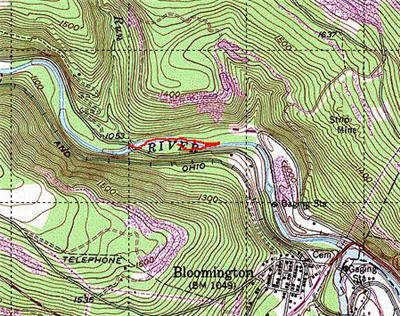At the end of a trip to the North Branch, we structured our day to give us a few hours to take the detour by Bloomington and hit the lower Savage. I had been to the upper section upstream from the Savage River Outfitters (great guys) and wanted to see some new water. I was put off a bit by the cautions related to a “rabid” landowner upstream of the first bridge, so I decided to walk down towards Bloomington and fish back.
There is a good pull-off on the northern bank on the left after you cross the bridge coming up from town. We parked there, and I headed downstream. Since we only had a limited amount of time, I only went about 3/4 mile before I turned around.
Walking on the southern bank is tight and tough! There is a large ridge that parallels the river, which is fully overgrown with vegetation. I kept veering away from the river to try and walk around it but discovered a steep cliff that sandwiches you between in and the dense growth. Nothing to do but fight downstream. Eventually, I broke out into the clear and could move a bit faster and put some distance behind me. I decided to start fishing and broke back through the brush into the riverbed, where I stumbled down the snot-slick rocks in the streambed until I reached a fairly large pool. Good enough.
I started to float nymphs downstream. I typically use a copper john on top with a beadhead for weight and then a light, small nymph as the dropper. I picked up a small trout here, but not much else moving. Switching to dries per the guidance from the Savage River guys, I floated them past some good rocks and under some branches, struggling to get that drag-free drift. Nothing on those.
I headed back upstream and realized, again, that the Savage has its own unique character. It seems like the river runs shallow, but when you poke your nose around a bit, you discover that it’s really a river of large rocks that have been tumbled together, which shelter deep cracks and protected holes that provide perfect cover for some nice fish. Now I understand the challenge of the Savage! It’s always been called an expert-level river – this must be why. You need to be able to get the fly to the exact right place at the right speed and right depth. Tough work for a new fly guy.
In this spot, it is complicated by the tight trees on the northern bank; as a right-handed guy, I found it easier to work the left bank as I could hang the line down the middle of the stream. However, if you cast upstream, you need to strip line in quickly, quickly, quickly or the current will sweep it away. Thinking streamers? Think hard. The standard across and drift downstream is close combat here. Not only is there limited room, but your streamer will find all those cracks in the rocks and hang up.

Savage River Trout Fishing Bottom Line: This is tough fishing. I’m not sure if this is good or bad. Given the reputation of the Savage, I’m sure it’s good…. if you are an expert or fish with hand grenades. For a novice like myself, I’ll put this one in the back pocket and return in a few years when I really know what I am doing.
The river is tough physically. You will die without a wading staff here. The rocks are slick. There is no easy path. If you come here by yourself have a “broken leg” plan. I carry a PLB – personal locator beacon – to make sure I can get help if I screw up and take a bad fall. All the above not enough caution? Add to this the fact that the fish laugh at you.
Getting There: Mapquest yourself to Bloomington, MD. As you come south across the bridge be alert for Savage River Road. Turn onto it and drive about a mile or so. When you get to the bridge, you are here. Park and go to it.
Google Local Coordinates: 39.486406,-79.082658
Secrets Revealed? No. This is a very public location that is documented in the following places:
Maryland DNR
Guide to Maryland Trout Fishing
Mid-Atlantic Budget Angler

I stopped at the pool you see in the distance.

Looking upstream from where I turned around

Plenty of parking on the right

This is the character of the Savage. Reasonably wide with the rocks providing cracks to hold the fish
Unless stated otherwise, this article was authored by Steve Moore


